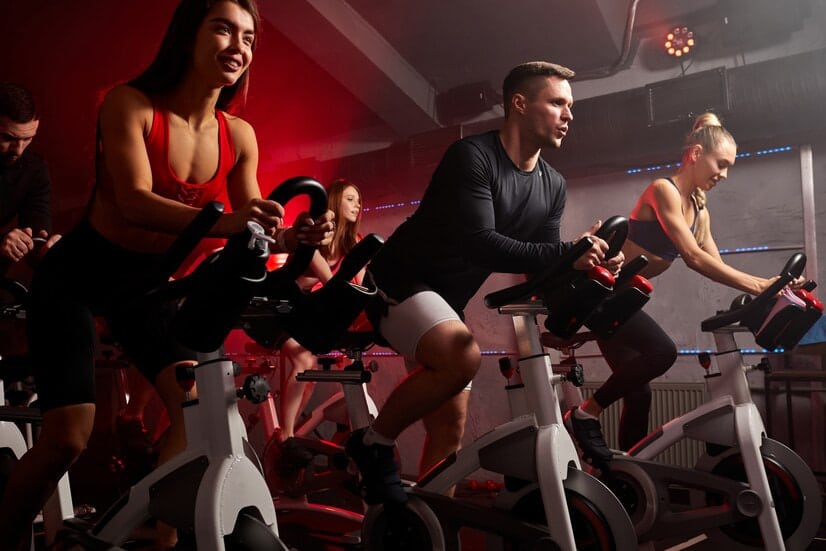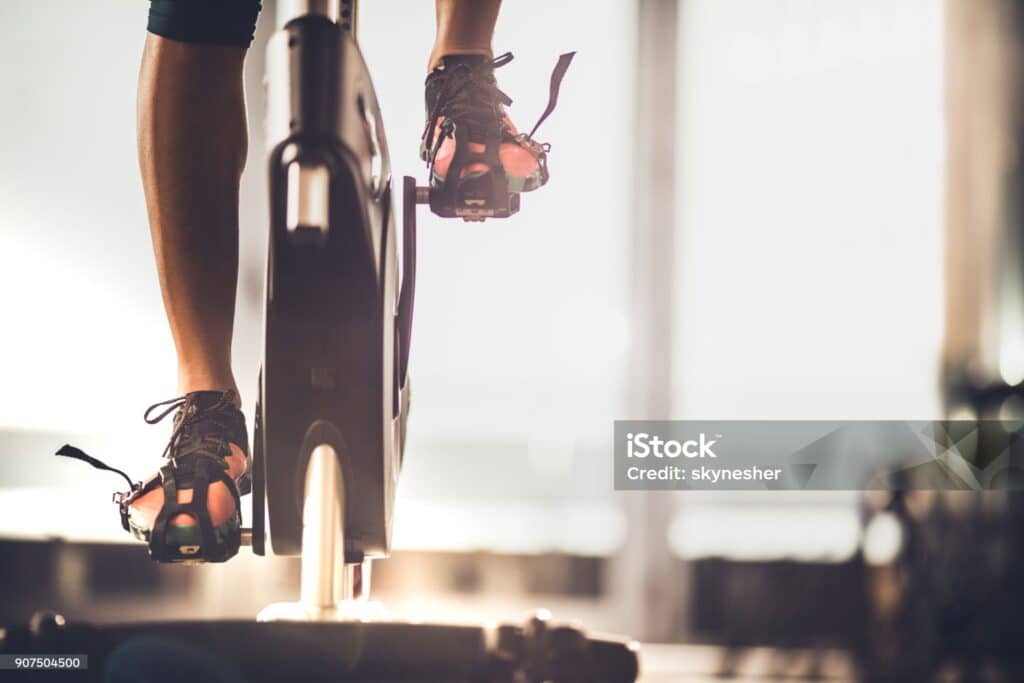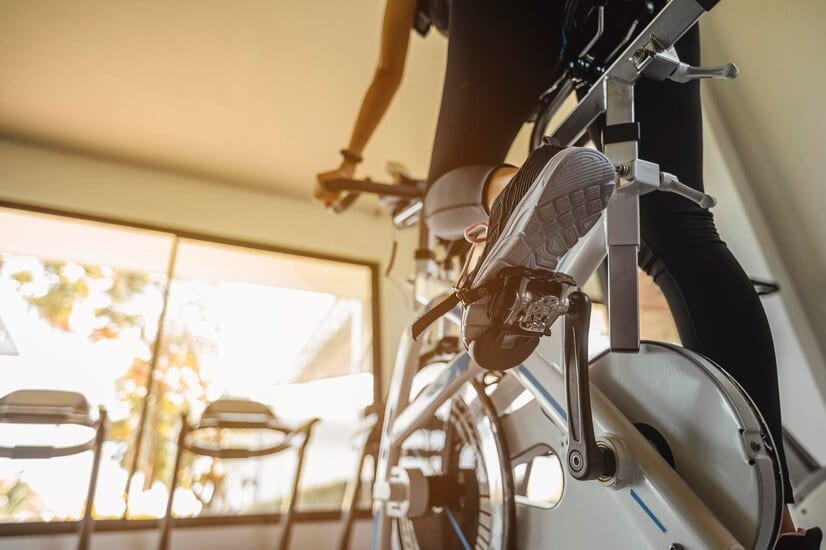
Summary
Welcome » Welcome » Tips for getting started » Pedalling technique: Master indoor cycling
Pedalling technique: Master indoor cycling
Looking to optimise your exercise bike sessions? Pedalling technique is the key to maximising cycling results, improving your performance and avoiding injury. In this article, we'll show you how to master every aspect of your pedalling.
Summary
Introduction to exercise bike pedalling techniques
From the correct position on the bike to the pedalling phases, you'll discover simple but effective tips for improving your endurance and power. You'll also learn how to correct common mistakes that limit your progress.
The importance of good pedalling technique
Mastering good pedalling technique on an exercise bike is essential to maximise the benefits of each training session. Efficient pedalling not only increases performance but also improves the overall quality of exercise. By adopting the right practices, you get the most out of your efforts and optimise your energy throughout the session.
- Impact on training efficiency
Good pedalling technique directly improves the effectiveness of your training. Each pedal stroke becomes more fluid, allowing you to maintain a higher cadence without tiring prematurely. You work smarter, not necessarily harder. - Preventing injuries and improving comfort
By adopting correct posture and controlling your movements, you reduce the risk of injury. Proper technique limits the strain on joints and muscles, making your sessions more enjoyable and longer-lasting. Remember, pedalling efficiently also means pedalling safely.
Differences between pedalling on the road and on an exercise bike
If you're used to cycling outdoors, it's important to know that the exercise bike requires a slightly different approach. Technique becomes even more crucial to compensate for certain elements that exist on the road but not indoors.
- No external factors (wind, terrain)
Unlike the road, there's no wind and no uphill or downhill terrain on an exercise bike. This means that you need to adapt your effort only in relation to the resistance of the machine. Consistency of movement is key to maintaining the correct intensity throughout your workout. - Greater emphasis on technique to maximise profits
In the absence of external challenges, the precision of your technique becomes even more important. Every movement must be thought through to maximise your effectiveness. A well-honed technique will enable you to optimise every minute of training, whether it's for endurance, strength or power.
Fundamentals of efficient pedalling
Correct position on the exercise bike
Before you start pedalling, it's essential that you adjust your exercise bike. Correct posture not only ensures more efficient pedalling, but also prevents muscle pain and injury.
- Saddle and handlebar adjustment
The first adjustment to make concerns the saddle. Make sure it's at a height where, when you pedal, your leg is almost fully extended at the lowest point of pedalling, but without locking your knee. The handlebars, meanwhile, should be positioned at a height where you can grip them without excessively arching your back. A posture that is too low will put strain on the lumbar region. - Body alignment for optimal pedalling
When you pedal, keep your back straight, your shoulders relaxed and your core engaged. Good body alignment provides a better distribution of effort and allows you to pedal for longer without discomfort. This position also helps you to breathe properly throughout your effort.
The phases of pedalling
Efficient pedalling is all about understanding and optimising your two main phases the pedal stroke: push and pull.
- Thrust phase (0° to 180°)
The push phase begins when the foot is at the top of the movement. By pressing firmly on the pedal, you activate the quadriceps and gluteal muscles to push the foot down. This is the phase where most of the force is produced. Remember to push with your heel to keep the movement fluid and powerful. - Pull phase (180° to 360°)
Less often mastered, the traction phase is just as important. Once the pedal has passed under your foot, pull it upwards by engaging the hamstring and calf muscles. This pull helps to make the movement more circular, avoiding the energy-wasting "piston stroke" pedalling.
Efficient pedalling is based on the fluidity of the two phases and allows the load to be distributed more evenly across all the leg muscles, optimising performance while reducing fatigue.
Basic techniques for efficient pedalling
Pedalling in circles
THE pedalling in circles is an essential basic technique for optimising the effectiveness of your sessions. Unlike 'piston stroke' pedalling, where the effort is concentrated solely on the pushing phase, this technique encourages a fluid, continuous movement.
- Description of the technique
Pedalling in circles involves distributing effort in a circular fashion throughout the pedal stroke, both during the push and pull phases. Imagine drawing a perfect circle with your feet, pushing firmly downwards, then pulling slightly upwards to maintain fluidity. This approach mobilises all your leg muscles, including the quadriceps, hamstrings and calves. - Benefits for endurance and power
By mastering this technique, you will considerably increase your endurance. The effort is distributed more evenly, enabling you to maintain a higher cadence over a longer period. Plus, pedalling in circles improves power by activating a greater number of muscle fibres with each pedal revolution, maximising your overall performance.
Heel-toe pedalling
The heel-toe pedalling is another effective method of improving muscle engagement, particularly in the calves.
- Explanation of the movement
This technique consists of initiating the pedal stroke with the heel when the pedal is at the top of the movement (at 12 o'clock), then making a gradual transition to the ball of the foot as the pedal descends. This allows a more balanced distribution of effort, activating more muscles in the leg. - Benefits for calf muscle engagement
If you apply this technique correctly, you will effectively stimulate the calves, strengthening this part of the body which is often under-utilised during traditional pedalling. Heel-toe pedalling improves muscular stability and strength while preventing cramp and tension caused by poorly distributed effort.
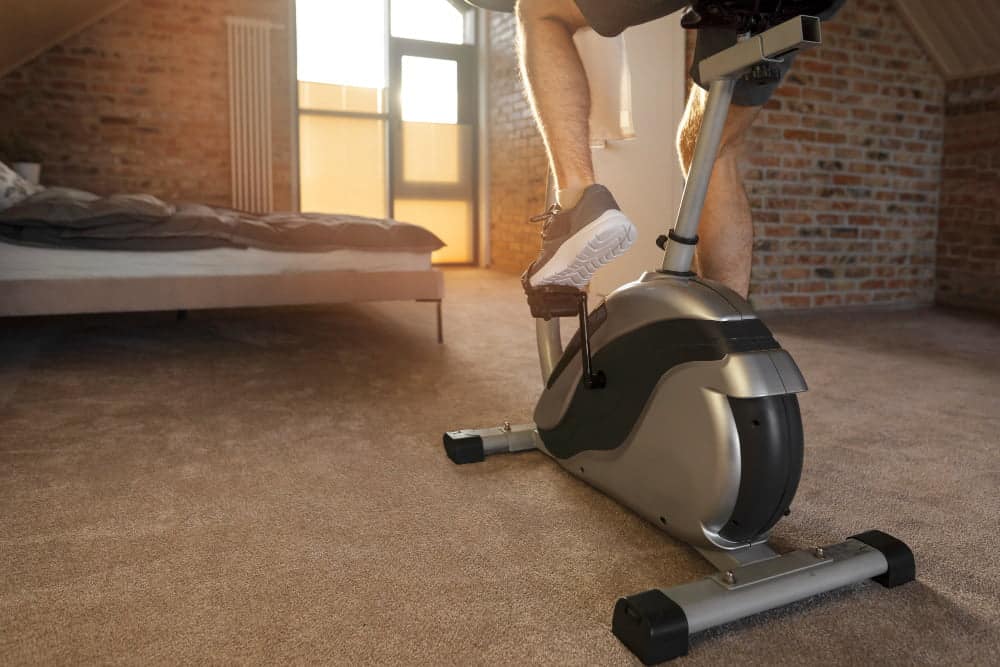
Advanced pedalling techniques
Single-leg pedalling
THE single-leg pedalling is an advanced technique for correcting muscular imbalances and improving fluidity of movement. Although it may seem difficult at first, this exercise is highly effective for perfecting your pedalling.
- Execution method
To perform this technique, pedal with one leg only, keeping the other raised or resting lightly on the bike frame. Concentrate on a complete circular movement, incorporating both push and pull. Alternate legs after a few minutes to avoid fatigue and ensure balanced work on both sides. - Improved fluidity and muscular balance
This technique helps to identify and correct weaknesses in each leg, often hidden by two-legged pedalling. It also improves coordination between the push and pull phases, making your pedalling smoother and more efficient in the long term.
Pedalling like a dancer
THE pedalling like a dancer is a dynamic and demanding technique that involves both the upper and lower body. It is mainly used to increase the intensity of training and imitate the climbs during a road session.
- Adaptation of the exercise bike technique
On an exercise bike, this technique involves rising from the saddle while maintaining a high resistance, simulating a climb. Keep your core engaged, arms slightly bent and hands firmly on the handlebars for better control. The movement should be fluid and controlled, with a balanced transfer of weight from one leg to the other. - Strengthening the upper body and varying the intensity
As well as putting more strain on the quadriceps and glutes, dancer pedalling actively engages the arms, shoulders and trunk. This technique also allows you to vary the intensity of your training, encouraging interval work and improving power and endurance.
Speed and resistance: finding the right balance
Understanding the relationship between speed and resistance
There cadence and the resistance are the two key parameters for effective training on an exercise bike. Finding the right balance between these two elements is crucial to achieving your goals, whether it's improving endurance, gaining power or burning calories.
- Defining the ideal cadence
The cadence corresponds to the number of pedal revolutions per minute (RPM). An ideal cadence is generally between 80 and 100 RPM for endurance training, but this can vary according to your level of fitness and your objectives. Too high a cadence without resistance can lead to inefficiency, while too low a cadence with too much resistance can lead to premature fatigue. - Adjusting resistance according to objectives
The resistance simulates the difficulties encountered on the road, such as climbs. By increasing the resistance, you work more on muscular strength, particularly in the legs. If you're aiming for greater endurance, moderate resistance with a regular cadence will be more suitable. To develop power and strength, opt for high resistance, with recovery periods between efforts.
Rate variation techniques
Varying your pace during a session is an effective strategy for diversifying the intensity of your training, avoiding monotony and stimulating different muscle groups.
- High-speed intervals
High cadence intervals, where you pedal at a fast pace with low to moderate resistance, are ideal for working on cardiovascular endurance and speed. These phases are often incorporated into HIIT-type training, alternating periods of intense effort with recovery phases. - Low cadence, high resistance pedalling
Conversely, low cadence pedalling with high resistance is ideal for strengthening leg muscles and improving power. These sequences can simulate difficult climbs and strengthen the quadriceps and glutes in particular, as well as developing strength.
Optimising technique for different objectives
Techniques for endurance
If your aim is to develop your endurance On an exercise bike, it's essential to use a moderate cadence and constant resistance. Endurance is built by repeating continuous, regular movements over long periods.
- Moderate pedalling and constant resistance
The key to developing your endurance is to maintain a cadence of between 80 and 90 RPM, with moderate resistance. This configuration helps to avoid premature exhaustion while optimising cardiovascular capacity. Remember to keep your pace steady and fluid, without forcing yourself unnecessarily. - The importance of regular movement
Smooth, even pedalling is crucial to maintaining your effort over time. A "piston stroke" or irregular movement will tire you more quickly and reduce the effectiveness of your training. Make sure you synchronise the push and pull phases to ensure a constant, smooth movement.
Techniques for strengthening muscles
For those who wish to strengthen their musclesIn order to strengthen the muscles, particularly the quadriceps, buttocks and calves, it is necessary to intensify efforts by using resistance and incorporating specific exercises.
- Using strong resistors
By significantly increasing the resistance, you can turn your pedalling into a real muscle-building exercise for your legs. Concentrate on a lower cadence, between 60 and 70 RPM, to maximise muscle work and promote strength gains. - Integration of dancer pedalling sequences
Dancer pedalling is an excellent exercise for strengthening both the lower and upper body. As you rise from the saddle, you work your quadriceps and glutes, as well as your core and arm muscles. Alternate between periods of seated and dancer pedalling to vary the intensity and strengthen your muscles overall.
Correction of common pedalling errors
Identifying bad habits
It is common practice to develop bad habits pedalling, especially if you don't pay particular attention to your technique. These mistakes can reduce the effectiveness of your sessions and lead to long-term injury.
- Piston stroke" pedalling
Piston stroke" pedalling is one of the most common errors. It occurs when the effort is concentrated solely on the pushing phase, neglecting the pulling phase. The result: a jerky movement that wastes energy and tires the muscles more quickly. To remedy this, try to visualise a circular movement, taking care to pull slightly on the pedal during the upward phase. - Excessive rocking of the pelvis
A swaying pelvis often indicates that the position on the bike is not correct or that the resistance is too low or too high. Such an imbalance can lead to pain in the lower back and hips. To correct this, check that the saddle is set at the right height and engage your core muscles to stabilise your posture.
Correction strategies
Correcting these errors requires concentration and practice. Fortunately, there are several strategies for improving your pedalling technique and avoiding these bad habits.
- Movement awareness exercises
The best way to correct inefficient pedalling is to consciously work on each phase of the movement. Specific exercises, such as single-leg pedalling, allow you to concentrate on the fluidity of your pedalling stroke and avoid the 'piston stroke'. You should also try to maintain a constant rhythm to strengthen muscle memory. - Use of mirrors or cameras for self-assessment
Self-assessment is an excellent way of spotting errors in posture or movement. You can install a small rear-view mirror or use a camera to record yourself during your session. This will allow you to analyse your movements and see whether your body remains aligned and stable while pedalling.
Specific training to perfect your technique
Targeted exercises for every aspect of pedalling
Perfecting your pedalling technique requires specific training, based on the following principles targeted exercises to improve each phase of the movement. These exercises will help you hone your skills and pedal more fluidly and efficiently.
- Fluidity drills
Fluidity drills are designed to help make your pedalling more circular. An excellent exercise is to pedal with one leg, as mentioned above. This helps you identify weak points in your pedalling stroke and work on the often neglected pull phase. Repeat this exercise for a few minutes on each leg to improve balance and fluidity. - Force-velocity sessions
This exercise consists of alternating between periods of high resistance at a low cadence and periods of low resistance at a high cadence. The aim is to improve both muscle power and the ability to maintain a fast cadence without compromising technique. Incorporate these sessions into your weekly programme for a complete workout.
Planning a technical improvement programme
A well-structured training programme is essential if you want to make lasting improvements to your pedalling technique. The aim is to incorporate specific sessions into your regular routine and progress step by step.
- Progression over 8 weeks
Over an 8-week period, you can build up a progressive programme. Start with fluidity drills, concentrating on technique. Gradually increase the duration and intensity of the exercises, incorporating strength-velocity sessions and high-cadence intervals. Each week, add new challenges to keep progressing. - Integrating technical sessions into an overall plan
For optimum results, make sure you incorporate these technical sessions into a complete training programme. Alternate between endurance, strength and technical sessions for a balanced workout. You could, for example, set aside one or two sessions a week to perfect your technique while continuing your overall work on power and endurance.
Impact of technology on performance and health
Performance gains thanks to optimised technology
A optimised pedalling technique is essential to maximise your performance on an exercise bike. Although the intensity of your training is important, the way you pedal has a direct influence on your results.
- Improved economy of effort
By mastering an efficient technique, you can make better use of your energy. Smooth, circular pedalling reduces unnecessary effort, so you can pedal for longer without tiring. A well-honed technique ensures that each pedal stroke produces maximum power while consuming as little energy as possible. - Increased power output
By optimising your movement, you can produce more power with less effort. Correct pedalling allows you to use all the muscles in your leg (quadriceps, calves, hamstrings), which increases your ability to maintain a high cadence or cope with greater resistance. The result: greater speed and strength, even during the most demanding training sessions.
Long-term health benefits
In addition to performance, good pedalling technique also has a considerable impact on your long-term health. Not only does it help prevent injury, it also improves posture and general well-being.
- Reduced risk of injury
Poor technique can lead to muscle strain and pain, particularly in the knees, hips and lower back. By working on correct posture and fluid movement, you minimise the risk of injury from overuse or muscle imbalance. - Better overall muscle activation
An optimised technique enables more complete activation of the muscles of the lower body, particularly the glutes, quadriceps and hamstrings. This improves overall posture, strengthens the core and promotes better body stability, all of which are essential for good day-to-day physical health.
Adapting the technique to different types of exercise bike
Upright bikes vs. semi-recumbent bikes
THE upright bicycles And semi-recumbent bicycles (or recumbents) require technical adjustments to get the most out of each session. Each type of bike puts different demands on the body and requires you to adapt your posture and pedalling technique.
- Technical adjustments required
On an upright bike, the posture is closer to that of a traditional road bike, with greater activation of the trunk muscles to stabilise the body. It's important to keep your back straight and adjust the saddle properly to avoid lower back pain. On a semi-recumbent bike, the body position is more relaxed and the back is fully supported. Here, the work is concentrated mainly on the legs, with less stress on the muscles of the upper body. - Advantages and disadvantages of pedalling technique
The upright bike provides a better transfer of power, particularly during high-intensity or high-resistance sessions, by putting more strain on the trunk and arm muscles. On the other hand, a semi-recumbent bike offers greater comfort for longer sessions, but can limit the power developed because of the more inclined position. So it's essential to adapt your technique according to the type of bike you use to optimise your results.
Specific features of connected exercise bikes
THE connected bikes offer unique features, enabling you to adjust your technique in real time thanks to precise data and instant feedback.
- Using real-time data to adjust your technique
Connected exercise bikes measure indicators such as cadence, power output and the distribution of effort between the legs. This data allows you to immediately correct any errors in technique, such as an imbalance between push and pull or a cadence that is too high without adequate resistance. Thanks to visual or audio feedback, you can adjust your pedalling in real time, optimising the effectiveness of each session.
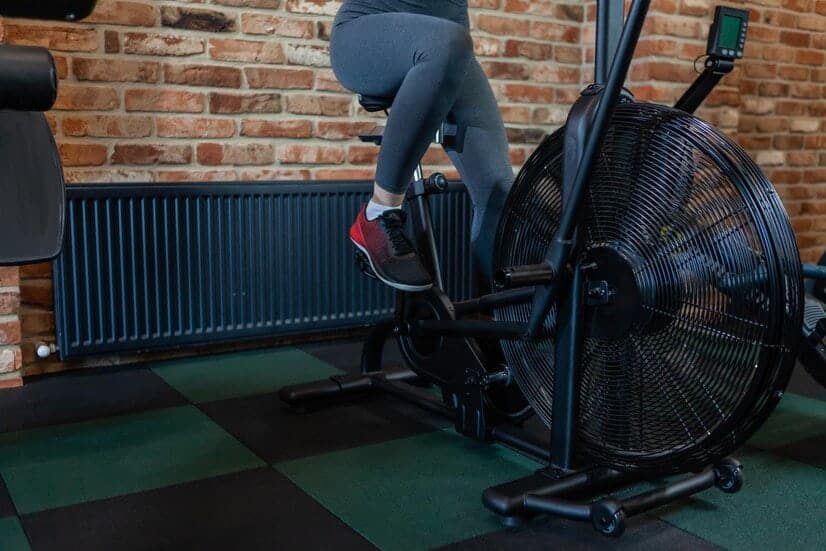
Conclusion
To optimise your exercise bike performance, it's essential to master pedalling techniques. Good posture, fluid pedalling and a balance between cadence and resistance will maximise your results while preventing injury.
By adapting your technique to your objectives, whether for endurance or muscle strengthening, you'll benefit from a more effective session. Every adjustment counts if you want to achieve your goals more quickly.
Ride an exercise bike with Space Cycle
Want to combine cycling and strength training? At SPACE CYCLE, our POWER RIDE session offers a complete workout that combines cardio and strength training, with a particular focus on the core muscles.
Enjoy a unique immersive experience, punctuated by light shows, an electric atmosphere and our motivating coaches, accompanied by exclusive playlists.
Join us for some memorable indoor cycling sessions in our Bonne Nouvelle or Bastille studios!
Read also
RPM how many times a week: Guide to optimising your sessions
Exercise bike benefits: why adopt it now?
Follow us
on instagram
To follow all our news,
take advantage of our tutorials and participate
in our many contests.
Breaking news!
Receive our newsletter.
